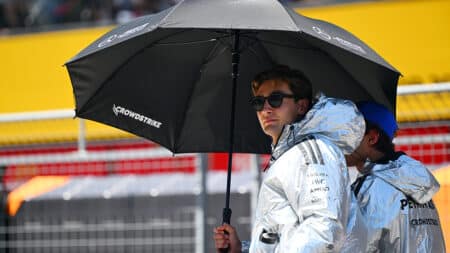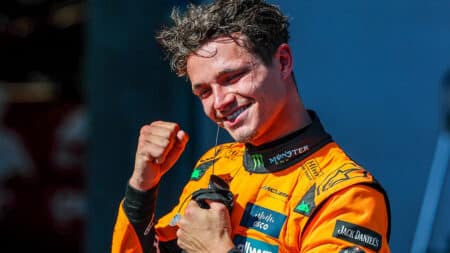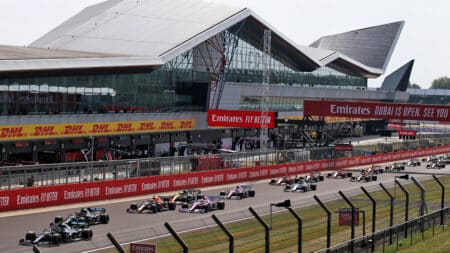
2025 is F1’s most polite title battle ever – Up/Down in Austria
Describing this year's championship race as a 'battle' might be slightly over-egging it, writes James Elson
There was a time when the Brazilian Grand Prix habitually featured as a beginning rather than an end and for a time was held in Rio rather than São Paulo.
Though there have been some cracking conclusions at Interlagos since its seasonal relocation of 2004, this writer has preferred always the eternal hope of spring, dawn over dusk.

Thirty years ago Formula 1 flew down to Rio to begin another new era. The year before had seen the rushed introduction of flat bottoms. On this occasion it was the restriction of race fuel to 220 litres.
Teams had had more time to prepare and several arrived with new models and many with new drivers. Ferrari, for instance, had landed Michele Alboreto, its first Italian GP driver since 1973.
But most significantly McLaren had designer John Barnard’s MP4/2 – with its bespoke TAG-Porsche V6 and Bosch Motronic engine management – plus Alain Prost.
The Frenchman’s rancorous departure from Renault had not only enabled Ron Dennis to get his new star on the cheap but also it provided Derek Warwick with a hard-earned lucrative opportunity.
After three seasons spent proving his stickability and eventually his speed with the improving but underfunded Toleman, the Hampshireman had not only joined a top team but also now had a strong claim to be the Régie’s number one.
The signs were good. Quick in testing, he qualified third behind the Lotus of Elio de Angelis and Alboreto and ahead of Prost. Approaching 30, he knew such momentum – he had finished in the points at the last four GPs of 1983 – was a precious commodity.
Neither a dawn nor dusk, it was time to make hay.
Life wasn’t so turbo-pressured seven rows further back, where Martin Brundle would begin his GP debut with Tyrrell as the fastest atmo qualifier. The 24-year-old from Norfolk admitted to his heart still missing a beat whenever he got into a slide yet he looked right at home.
Directly ahead of him was fellow F1 newcomer and familiar Formula 3 sparring partner Ayrton Senna. The Brazilian was widely tipped for greatness but there seemed no earthly reason why Brundle couldn’t hound him all the way.
This anticipation had to be placed on hold, however, when Andrea de Cesaris could find only neutral in his Ligier’s gearbox.
Thirty minutes later, the race reduced by a lap, Alboreto got the jump on de Angelis, as did Warwick. The crowd hardly noticed because local hero Nelson Piquet’s Brabham stalled and had to be push-started.
Though Alboreto eased away, Warwick tracked him and felt confident in the feel of his RE50. Like everybody else, however, he had noted the speed of the McLarens in morning warm-up.
Prost took it gently to begin with and so it was Niki Lauda’s MP4/2 that loomed first in Warwick’s mirrors.
The Austrian, already feeling the pressure of Prost’s presence, was in determined mood and his pass, when it came on lap 10, was ruder than usual, a late jink bringing his right-rear into contact with the Renault’s left-front.
It didn’t look like much, but Warwick would later confirm it as being “quite a bang”.
Two laps later Lauda took the lead when Alboreto spun twice and into retirement because of a failed front caliper.
Not long later Prost passed Warwick for second.
The McLarens’ pace remained ominous but the race was turning attritional and Warwick kept pushing. Having stopped for new rubber on lap 29, he immediately made the most of it by setting a fastest lap.
That default determination paid off on lap 38. Lauda was slowing – Keke Rosberg in a Williams and de Angelis had unlapped themselves – and he was heading to his pit because of a fractured solder on a battery cable as Prost dived by to make his tyre stop.
When a sticking rear wheel nut cost the latter 20 extra seconds, Warwick hit the front.
It all came flooding back: how easy it can be to lead in a good car. He had driven harder and yet failed to qualify in times gone by.
This is what he had worked so long for. He had seen enough to realise that a GP victory wouldn’t change everything but knew that it would alter a very great deal: cement his standing in a re-energised team.

But, what was that?
A worsening vibration that became a sickening shudder with 10 laps remaining.
In a delayed reaction from Lauda’s jab, a wishbone buckled, causing Warwick to spin. And so it would be Prost who cemented his standing in a re-energised team.
Brundle, meanwhile, continued to impress with his smooth speed and sensible approach. When Patrick Tambay, Warwick’s team-mate, ran out of Elf two laps from home, he moved up yet another place to finish fifth.
At that very moment he joined Warwick ahead of Nigel Mansell – who crashed out of a points-scoring position – in the British F1 pecking order. Warwick was its man of the moment and medium-term; Brundle was its future star with time on his side.
Warwick bounced back from his Brazilian disappointment by finishing (admittedly distant) third, second and fourth, at Kyalami, Zolder and Imola, and Brundle reinforced his promise by coming within a second of winning in Detroit.
But momentum is fickle for all but the few.
Warwick, who set fastest lap in Motown before recording his fourth successive retirement, had suffered badly bruised legs when a suspension arm penetrated his cockpit in a crash at Dijon. A further shunt at Monaco had aggravated those injuries.
His momentum was ebbing.
Worse befell Brundle.

After escaping a violent accident that caused him to DNQ at Monaco – an opportunity missed given the rain of race day – a practice shunt at Dallas left him with leg injuries that curtailed his season.
His momentum had halted.
Warwick also fell foul of the temporary, crumbling Fair Park track, crashing out when making a hasty outside pass in a bid to take the lead from… Mansell.
Having started from his maiden pole position, the latter clung tenaciously and impassively to first place, while under pressure from a variety of rivals, for 35 laps.
His was the sort of performance that quietened critics – he had crashed while leading in Monaco – and perhaps caught the eye of potential employers, while its melodramatic denouement – a pushed finish in searing heat to sixth, a point and physical collapse – was the sort of performance that won fans who might otherwise have taken no notice.

There was a certain something about Mansell that Warwick and Brundle didn’t have – and it was just beginning to show.
Warwick’s destiny was still in his own hands, however, and there was just enough showing at Renault – notably a second place at Brands Hatch – for him to politely decline Williams’ offer for 1985.
Mansell, a man with fewer options, grabbed it.
Almost 30 years later Lewis Hamilton has succeeded in overtaking Mansell as Britain’s most statistically successful F1 driver, with 32 wins from 146 starts.
Warwick and Brundle combined to score none from 305.
Thus they must be judged on different bases (sic).

Those two second places apiece; Brundle’s Detroit performance was erased when Tyrrell was retrospectively excluded for running, ahem, unsecured ballast. Their restorative spells in TWR Jaguar sports cars. Their victory near misses in Canada. And their steely clambers from destroyed yellow-gold cars and steady jogs to the awaiting spare.
Their unfashionable, hard-knocks short-oval backgrounds. Their natural willingness and ability to express entertainingly – with disarming and misleading bumpkin burrs – a deep love for and understanding of the sport. And their knack of being equally liked and admired by those who know them well, those who have met them once or twice and those who never have.
That nice guys don’t win in F1 is hokum. Yes, these two didn’t. But that was due mainly to momentum.

Describing this year's championship race as a 'battle' might be slightly over-egging it, writes James Elson

You had to read between the lines at the 2025 Austrian Grand Prix as George Russell dropped hints over about his dissatisfaction, and F1 sent a message to FIA president Mohammed Ben Sulayem

From zero to hero: in a pacy McLaren, at one of his favourite F1 circuits, Lando Norris picked himself up from a disastrous Canadian race to reign supreme in the 2025 Austrian Grand Prix

Full F1 schedule for the year, including the next F1 race of 2025: the British Grand Prix at Silverstone, the whole calendar and circuit guides for the 24-race Formula 1 season